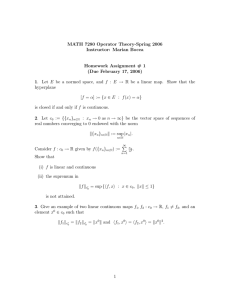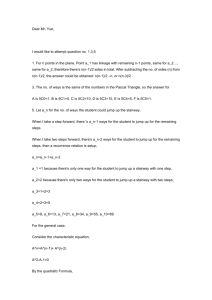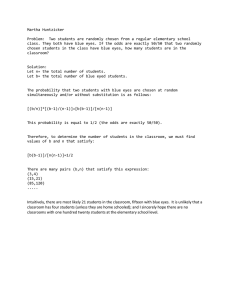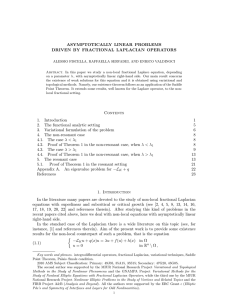Brownian Motion Chapter 9
advertisement
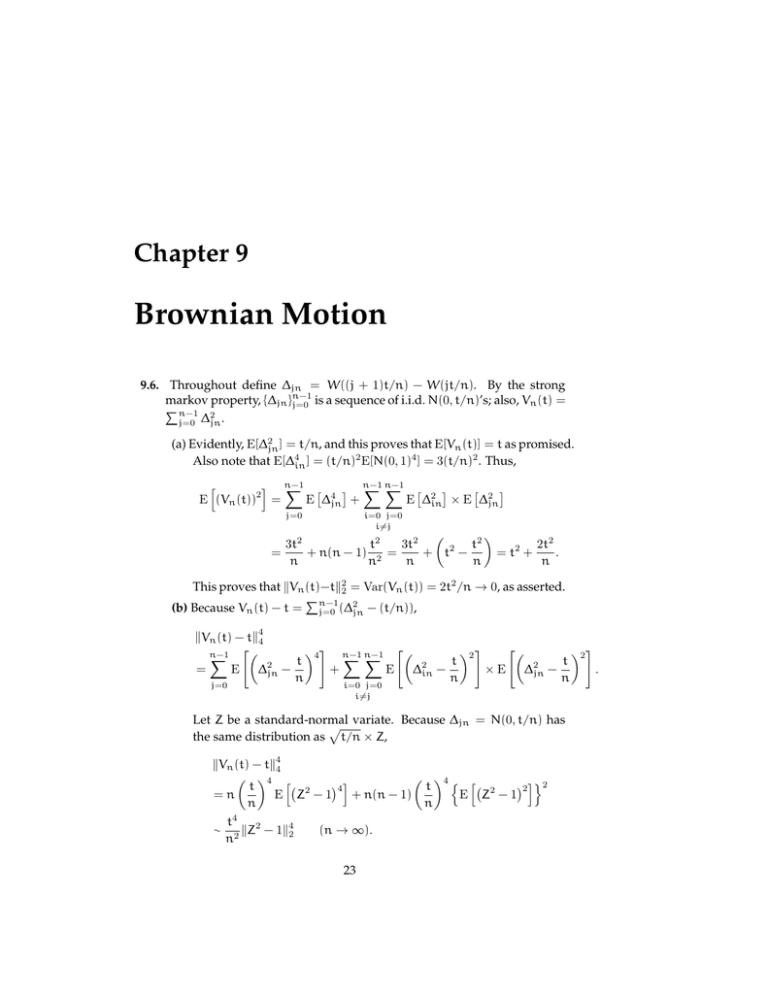
Chapter 9
Brownian Motion
9.6. Throughout define jn = W((j + 1)t/n) - W(jt/n). By the strong
n-1
markov property, { jn }j=0
is a sequence of i.i.d. N(0, t/n)’s; also, Vn (t) =
Pn-1 2
j=0
jn .
(a) Evidently, E[ 2jn ] = t/n, and this proves that E[Vn (t)] = t as promised.
Also note that E[ 4in ] = (t/n)2 E[N(0, 1)4 ] = 3(t/n)2 . Thus,
h
i n-1
X ⇥
E (Vn (t))2 =
E
j=0
=
4
jn
⇤
+
n-1
X n-1
X
E
i=0 j=0
i6=j
⇥
2
in
⇤
⇥E
⇥
2
jn
⇤
✓
◆
3t2
t2
3t2
t2
2t2
+ n(n - 1) 2 =
+ t2 = t2 +
.
n
n
n
n
n
This proves that kVn (t)-tk22 = Var(Vn (t)) = 2t2 /n ! 0, as asserted.
P
2
(b) Because Vn (t) - t = n-1
j=0 ( jn - (t/n)),
kVn (t) - tk44
"✓
"✓
◆4 # n-1
n-1
X
X n-1
X
t
2
=
E
+
E
jn n
j=0
i=0 j=0
i6=j
t
2
in n
Let Z be a standard-normal
p variate. Because
the same distribution as t/n ⇥ Z,
◆2 #
jn
⇥E
"✓
t
2
jn n
= N(0, t/n) has
kVn (t) - tk44
✓ ◆4 h
✓ ◆4 ⌦ h
i
i↵2
t
t
4
2
2
=n
E Z -1
+ n(n - 1)
E Z2 - 1
n
n
4
t
⇠ 2 kZ2 - 1k42
(n ! 1).
n
23
◆2 #
.
24
CHAPTER 9. BROWNIAN MOTION
Therefore, kVn (t) - tk4 ⇠ cn-1/2 for some c, and this yields the
desired bound.
9.10. The key observation is that B is independent of W(1). Indeed, note that
for all 0 < t1 < . . . < tk < 1, (B(t1 ), . . . , B(tk ), W(1)) is a centered normal
random variable. Therefore, it suffices to show that E[B(ti )W(1)] = 0, but
this is easy to check. Now,
h Pm
i
E ei j=1 uj W(tj ) |W(1)| 6 "
h Pm
i h Pm
i
= E ei j=1 uj B(tj ) E ei j=1 uj W(1) |W(1)| 6 " .
As for the second term, conditional on |W(1)| 6 ",
0
0
1
1
m
m
m
⇣ Pm
⌘
X
X
X
Im ei j=1 uj W(1) = sin @
uj W(1)A 6 sin @"
|uj |A 6 "
|uj |,
j=1
j=1
j=1
P
for all " 2 (0, 1/ m
j=1 |uj |). This is because sin is increasing on (0, 1), and
| sin x| = sin x 6 x there. This proves that
m
⇣ h Pm
i⌘
X
i j=1 uj W(1)
Im E e
|W(1)| 6 " 6 "
|uj | ! 0
j=1
as " ! 0.
Similarly, Re(· · · ) ! 1. This proves the result.
9.11. Let Wt = ({W(u) - W(t)}u>t ), so that W = \t>0 Wt . Note that T is
the P-completion of W. Therefore, for all A 2 T we can find A⇤ 2 W
such that P(A4A⇤ ) = 0. By the Markov property, A⇤ is independent of
Ft0 for all t. Therefore, A⇤ is independent of _t>0 Ft0 . Since A⇤ 2 _t>0 Ft0 ,
it is independent of itself; hence it has probability zero or one. Because
P(A) = P(A⇤ ), this proves that any element of T has probability zero or
one, which is the first assertion. Blumenthal’s zero-one law follows upon
applying this result to the Brownian motion {t(W1/t)}t>0 .




